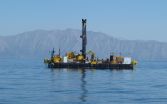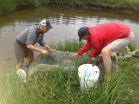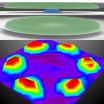Climate capers of the past 600,000 years
The Lake Van drilling project brings to light a unique archive; research project under the auspices of Bonn University
2014-11-17
(Press-News.org) If you want to see into the future, you have to understand the past. An international consortium of researchers under the auspices of the University of Bonn has drilled deposits on the bed of Lake Van (Eastern Turkey) which provide unique insights into the last 600,000 years. The samples reveal that the climate has done its fair share of mischief-making in the past. Furthermore, there have been numerous earthquakes and volcanic eruptions. The results of the drilling project also provide a basis for assessing the risk of how dangerous natural hazards are for today's population. In a special edition of the highly regarded publication Quaternary Science Reviews, the scientists have now published their findings in a number of journal articles.
In the sediments of Lake Van, the lighter-colored, lime-containing summer layers are clearly distinguishable from the darker, clay-rich winter layers -- also called varves. In 2010, from a floating platform an international consortium of researchers drilled a 220 m deep sediment profile from the lake floor at a water depth of 360 m and analyzed the varves. The samples they recovered are a unique scientific treasure because the climate conditions, earthquakes and volcanic eruptions of the past 600,000 years can be read in outstanding quality from the cores.
The team of scientists under the auspices of the University of Bonn has analyzed some 5,000 samples in total. "The results show that the climate over the past hundred thousand years has been a roller coaster. Within just a few decades, the climate could tip from an ice age into a warm period," says Doctor Thomas Litt of the University of Bonn's Steinmann Institute and spokesman for the PALEOVAN international consortium of researchers. Unbroken continental climate archives from the ice age which encompass several hundred thousand years are extremely rare on a global scale. "There has never before in all of the Middle East and Central Asia been a continental drilling operation going so far back into the past," says Doctor Litt. In the northern hemisphere, climate data from ice-cores drilled in Greenland encompass the last 120,000 years. The Lake Van project closes a gap in the scientific climate record.
The sediments reveal six cycles of cold and warm periods
Scientists found evidence for a total of six cycles of warm and cold periods in the sediments of Lake Van. The University of Bonn paleoecologist and his colleagues analyzed the pollen preserved in the sediments. Under a microscope they were able to determine which plants around the eastern Anatolian Lake the pollen came from. "Pollen is amazingly durable and is preserved over very long periods when protected in the sediments," Doctor Litt explained. Insight into the age of the individual layers was gleaned through radiometric age measurements that use the decay of radioactive elements as a geologic clock. Based on the type of pollen and the age, the scientists were able to determine when oak forests typical of warm periods grew around Lake Van and when ice-age steppe made up of grasses, mugwort and goosefoot surrounded the lake.
Once they determine the composition of the vegetation present and the requirements of the plants, the scientists can reconstruct with a high degree of accuracy the temperature and amount of rainfall during different epochs. These analyses enable the team of researchers to read the varves of Lake Van like thousands of pages of an archive. With these data, the team was able to demonstrate that fluctuations in climate were due in large part to periodic changes in the Earth's orbit parameters and the commensurate changes in solar insolation levels. However, the influence of North Atlantic currents was also evident. "The analysis of the Lake Van sediments has presented us with an image of how an ecosystem reacts to abrupt changes in climate. This fundamental data will help us to develop potential scenarios of future climate effects," says Doctor Litt.
Risks of earthquakes and volcanic eruptions in the region of Van
Such risk assessments can also be made for other natural forces. "Deposits of volcanic ash with thicknesses of up to 10 m in the Lake Van sediments show us that approximately 270,000 years ago there was a massive eruption," the University of Bonn paleoecologist said. The team struck some 300 different volcanic events in its drillings. Statistically, that corresponds to one explosive volcanic eruption in the region every 2000 years. Deformations in the sediment layers show that the area is subject to frequent, strong earthquakes. "The area around Lake Van is very densely populated. The data from the core samples show that volcanic activity and earthquakes present a relatively high risk for the region," Doctor Litt says. According to media reports, in 2011 a 7.2 magnitude earthquake in the Van province claimed the lives of more than 500 people and injured more than 2,500.
INFORMATION:
Publication: "Results from the PALEOVAN drilling project: A 600,000 year long continental archive in the Near East", Quaternary Science Reviews, Volume 104, online publication: (http://dx.doi.org/10.1016/j.quascirev.2014.09.026)
Media contact:
Prof. Dr. Thomas Litt
Steinmann Institute, the University of Bonn
Tel. ++49-(0)228-732736
E-mail: t.litt@uni-bonn.de
ELSE PRESS RELEASES FROM THIS DATE:
2014-11-17
WASHINGTON, D.C. - Two or more serious hits to the head within days of each other can interfere with the brain's ability to use sugar - its primary energy source - to repair cells damaged by the injuries, new research suggests.
The brain's ability to use energy is critical after an injury. In animal studies, Ohio State University scientists have shown that brain cells ramp up their energy use six days after a concussion to recover from the damage. If a second injury occurs before that surge of energy use starts, the brain loses its best chance to recover.
In mice, ...
2014-11-17
Mikhail Kosiborod, M.D., of Saint Luke's Mid America Heart Institute, Kansas City, and colleagues evaluated the efficacy and safety of the drug zirconium cyclosilicate in patients with hyperkalemia (higher than normal potassium levels). The study appears in JAMA and is being released to coincide with its presentation at the American Heart Association's Scientific Sessions 2014.
Hyperkalemia is a common electrolyte disorder which can cause potentially life-threatening cardiac arrhythmias and is associated with chronic kidney disease, heart failure, and diabetes mellitus. ...
2014-11-17
BLOOMINGTON, Ind. -- An Indiana University-Dartmouth College team has identified genes and regulatory patterns that allow some organisms to alter their body form in response to environmental change.
Understanding how an organism adopts a new function to thrive in a changing environment has implications for molecular evolution and many areas of science including climate change and medicine, especially in regeneration and wound healing.
The study, which appears in the journal Molecular Biology and Evolution, provides insight into phenotypic plasticity, a phenomenon that ...
2014-11-17
November 17, 2014, PORTLAND, Ore. -- People who received automated reminders were more likely to refill their blood pressure and cholesterol medications, according to a study published today in a special issue of the American Journal of Managed Care.
The study, which included more than 21,000 Kaiser Permanente members, found that the average improvement in medication adherence was only about 2 percentage points, but the authors say that in a large population, even small changes can make a big difference.
"This small jump might not mean a lot to an individual patient, ...
2014-11-17
This news release is available in Spanish.
Although maize was originally domesticated in Mexico, the country's average yield per hectare is 38% below the world's average. In fact, Mexico imports 30% of its maize from foreign sources to keep up with internal demand.
To combat insect pests, Mexican farmers rely primarily on chemical insecticides. Approximately 3,000 tons of active ingredient are used each year just to manage the fall armyworm (Spodoptera frugiperda), in addition to even more chemicals used to control other pests such as the corn earworm (Helicoverpa ...
2014-11-17
In the aquatic environment, suction feeding is far more common than biting as a way to capture prey. A new study shows that the evolution of biting behavior in eels led to a remarkable diversification of skull shapes, indicating that the skull shapes of most fish are limited by the structural requirements for suction feeding.
"When you look at the skulls of biters, the diversity is astounding compared to suction feeders," said Rita Mehta, assistant professor of ecology and evolutionary biology at UC Santa Cruz.
With more than 800 species, including both suction feeders ...
2014-11-17
For the first time, scientists have vividly mapped the shapes and textures of high-order modes of Brownian motions--in this case, the collective macroscopic movement of molecules in microdisk resonators--researchers at Case Western Reserve University report.
To do this, they used a record-setting scanning optical interferometry technique, described in a study published today in the journal Nature Communications.
The new technology holds promise for multimodal sensing and signal processing, and to develop optical coding for computing and other information-processing ...
2014-11-17
Chronic myeloid leukemia develops when a gene mutates and causes an enzyme to become hyperactive, causing blood-forming stem cells in the bone marrow to grow rapidly into abnormal cells. The enzyme, Abl-kinase, is a member of the "kinase" family of enzymes, which serve as an "on" or "off" switch for many functions in our cells. In chronic myeloid leukemia, the hyperactive Abl-kinase is targeted with drugs that bind to a specific part of the enzyme and block it, aiming to ultimately kill the fast-growing cancer cell. However, treatments are often limited by the fact that ...
2014-11-17
One of the key reasons the Ebola outbreak got out of control in West Africa in the early days of the crisis was a lack of trust among community members, frontline health workers and the broader health system, suggests new Johns Hopkins Bloomberg School of Public Health research.
Had the citizens and their health care community developed a trusting relationship prior to the outbreak, important messages about the disease and how to stop its spread would likely have gotten through to people much sooner and slowed the march of Ebola, says Timothy Roberton, MPH, MA, a DrPH ...
2014-11-17
People who frequently cook meals at home eat healthier and consume fewer calories than those who cook less, according to new Johns Hopkins Bloomberg School of Public Health research.
"When people cook most of their meals at home, they consume fewer carbohydrates, less sugar and less fat than those who cook less or not at all - even if they are not trying to lose weight," says Julia A. Wolfson, MPP, a CLF-Lerner Fellow at the Johns Hopkins Center for a Livable Future and lead author of the study.
The findings also suggest that those who frequently cooked at home - six-to-seven ...
LAST 30 PRESS RELEASES:
[Press-News.org] Climate capers of the past 600,000 years
The Lake Van drilling project brings to light a unique archive; research project under the auspices of Bonn University





